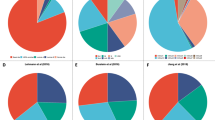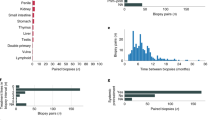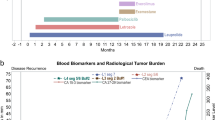Abstract
Breast cancer (BC) has been classified into four intrinsic subtypes through seminal studies employing gene expression profiling analysis of primary tumours, namely the luminal A and B subtypes, the human epidermal growth factor receptor 2-like subtype and the basal-like subtype. More recently, the emergence of high-throughput genomic sequencing techniques, such as next-generation or massive parallel sequencing has expanded our understanding of the complex genomic landscapes of BC, with marked intertumour heterogeneity seen among different patients. In addition, increasing evidence indicates intratumour heterogeneity, with molecular differences observed within one patient, both spatially and longitudinally. These phenomena have an impact on the clinical development of molecularly targeted agents, with the classical paradigm of population-based clinical trials being no longer efficient. In the era of genomically driven oncology, three complementary tools can accelerate the clinical development of targeted agents for advanced BC as follows: (i) the implementation of molecular profiling of metastatic tumour lesions, as exemplified by the AURORA (Aiming to Understand the Molecular Aberrations in Metastatic Breast Cancer) programme; (ii) serial assessments of circulating tumour DNA, allowing a more thorough molecular interrogation of metastatic tumour burden; and (iii) new innovative clinical trial designs able to address the challenges of the increasing molecular fragmentation of BC.
This is a preview of subscription content, access via your institution
Access options
Subscribe to this journal
Receive 50 print issues and online access
$259.00 per year
only $5.18 per issue
Buy this article
- Purchase on Springer Link
- Instant access to full article PDF
Prices may be subject to local taxes which are calculated during checkout


Similar content being viewed by others
References
Ferlay J, Soerjomataram I, Ervik M, Dikshit R, Eser S, Mathers C et al GLOBOCAN 2012 v1.0, Cancer Incidence and Mortality Worldwide: IARC CancerBase No. 11 (Internet). International Agency for Research on Cancer: Lyon, France; 2013. Available from: http://globocan.iarc.fr.
Hudis CA . Trastuzumab — mechanism of action and use in clinical practice. N Engl J Med 2007; 357: 39–51.
Ades F, Zardavas D, Aftimos P, Awada A . Anticancer drug development: moving away from the old habits. Curr Opin Oncol 2014; 26: 334–339.
Zardavas D, Pugliano L, Piccart M . Personalized therapy for breast cancer: a dream or a reality? Future Oncol 2013; 9: 1105–1119.
Perou CM, Sørlie T, Eisen MB, van de Rijn M, Jeffrey SS, Rees CA et al. Molecular portraits of human breast tumours. Nature 2000; 406: 747–752.
Sorlie T, Tibshirani R, Parker J, Hastie T, Marron JS, Nobel A et al. Repeated observation of breast tumor subtypes in independent gene expression data sets. Proc Natl Acad Sci USA 2003; 100: 8418–8423.
Sotiriou C, Neo SY, McShane LM, Korn EL, Long PM, Jazaeri A et al. Breast cancer classification and prognosis based on gene expression profiles from a population-based study. Proc Natl Acad Sci USA 2003; 100: 10393–10398.
Ades F, Zardavas D, Bozovic-Spasojevic I, Pugliano L, Fumagalli D, de Azambuja E et al. Luminal B breast cancer: molecular characterization, clinical management, and future perspectives. J Clin Oncol 2014; 32: 2794–2803.
Arteaga CL, Sliwkowski MX, Osborne CK, Perez EA, Puglisi F, Gianni L . Treatment of HER2-positive breast cancer: current status and future perspectives. Nat Rev Clin Oncol 2011; 9: 16–32.
Zardavas D, Cameron D, Krop I, Piccart M . Beyond trastuzumab and lapatinib: new options for HER2-positive breast cancer. Am Soc Clin Oncol Educ Book 2013 doi:10.1200/EdBook_AM.2013.33.e2.
Foulkes WD, Smith IE, Reis-Filho JS . Triple-negative breast cancer. N Engl J Med 2010; 363: 1938–1948.
Badve S, Dabbs DJ, Schnitt SJ, Baehner FL, Decker T, Eusebi V et al. Basal-like and triple-negative breast cancers: a critical review with an emphasis on the implications for pathologists and oncologists. Mod Pathol 2011; 24: 157–167.
Curtis C, Shah SP, Chin SF, Turashvili G, Rueda OM, Dunning MJ et alMETABRIC Group. The genomic and transcriptomic architecture of 2,000 breast tumours reveals novel subgroups. Nature 2012; 486: 346–352.
Banerji S, Cibulskis K, Rangel-Escareno C, Brown KK, Carter SL, Frederick AM et al. Sequence analysis of mutations and translocations across breast cancer subtypes. Nature 2012; 486: 405–409.
Ellis MJ, Ding L, Shen D, Luo J, Suman VJ, Wallis JW et al. Whole-genome analysis informs breast cancer response to aromatase inhibition. Nature 2012; 486: 353–360.
Cancer Genome Atlas Network. Comprehensive molecular portraits of human breast tumours. Nature 2012; 490: 61–70.
Shah SP, Roth A, Goya R, Oloumi A, Ha G, Zhao Y et al. The clonal and mutational evolution spectrum of primary triple-negative breast cancers. Nature 2012; 486: 395–399.
Stephens PJ, Tarpey PS, Davies H, Van Loo P, Greenman C, Wedge DC et al. The landscape of cancer genes and mutational processes in breast cancer. Nature 2012; 486: 400–404.
Muller PA, Vousden KH . Mutant p53 in cancer: new functions and therapeutic opportunities. Cancer Cell 2014; 25: 304–317.
Yan M, Parker BA, Schwab R, Kurzrock R . HER2 aberrations in cancer: implications for therapy. Cancer Treat Rev 2014; 40: 770–780.
Vogelstein B, Papadopoulos N, Velculescu VE, Zhou S, Diaz LA Jr, Kinzler KW . Cancer genome landscapes. Science 2013; 339: 1546–1558.
Zardavas D, Baselga J, Piccart M . Emerging targeted agents in metastatic breast cancer. Nat Rev Clin Oncol 2013; 10: 191–210.
Eirew P, Steif A, Khattra J, Ha G, Yap D, Farahani H et al. Dynamics of genomic clones in breast cancer patient xenografts at single-cell resolution. Nature 2015; 518: 422–426.
Shah SP, Morin RD, Khattra J, Prentice L, Pugh T, Burleigh A et al. Mutational evolution in a lobular breast tumour profiled at single nucleotide resolution. Nature 2009; 461: 809–813.
Zardavas D, Irrthum A, Swanton C, Piccart M . Clinical management of breast cancer heterogeneity. Nat Rev Clin Oncol 2015, e-pub print of head 21 April 2015 doi:10.1038/nrclinonc.2015.73.
Gonzalez-Angulo AM, Ferrer-Lozano J, Stemke-Hale K, Sahin A, Liu S, Barrera JA et al. PI3K pathway mutations and PTEN levels in primary and metastatic breast cancer. Mol Cancer Ther 2011; 10: 1093–1101.
Dupont Jensen J, Laenkholm AV, Knoop A, Ewertz M, Bandaru R, Liu W et al. PIK3CA mutations may be discordant between primary and corresponding metastatic disease in breast cancer. Clin Cancer Res 2011; 17: 667–677.
Ding L, Ellis MJ, Li S, Larson DE, Chen K, Wallis JW et al. Genome remodelling in a basal-like breast cancer metastasis and xenograft. Nature 2010; 464: 999–1005.
Zardavas D, Maetens M, Irrthum A, Goulioti T, Engelen K, Fumagalli D et al. The AURORA initiative for metastatic breast cancer. Br J Cancer 2014; 111: 1881–1887.
Curigliano G, Bagnardi V, Viale G, Fumagalli L, Rotmensz N, Aurilio G et al. Should liver metastases of breast cancer be biopsied to improve treatment choice? Ann Oncol 2011; 22: 2227–2233.
Curtit E, Nerich V, Mansi L, Chaigneau L, Cals L, Villanueva C et al. Discordances in estrogen receptor status, progesterone receptor status, and HER2 status between primary breast cancer and metastasis. Oncologist 2013; 18: 667–674.
de Dueñas EM, Hernández AL, Zotano AG, Carrión RM, López-Muñiz JI, Novoa SA et al. Prospective evaluation of the conversion rate in the receptor status between primary breast cancer and metastasis: results from the GEICAM 2009-03 ConvertHER study. Breast Cancer Res Treat 2014; 143: 507–515.
Duchnowska R, Dziadziuszko R, Trojanowski T, Mandat T, Och W, Czartoryska-Arłukowicz B et alPolish Brain Metastasis Consortium. Conversion of epidermal growth factor receptor 2 and hormone receptor expression in breast cancer metastases to the brain. Breast Cancer Res 2012; 14: R119.
Macfarlane R, Seal M, Speers C, Woods R, Masoudi H, Aparicio S et al. Molecular alterations between the primary breast cancer and the subsequent locoregional/metastatic tumor. Oncologist 2012; 17: 172–178.
Nedergaard L, Haerslev T, Jacobsen GK . Immunohistochemical study of estrogen receptors in primary breast carcinomas and their lymph node metastases including comparison of two monoclonal antibodies. APMI 1995; 103: 20–24.
Simmons C, Miller N, Geddie W, Gianfelice D, Oldfield M, Dranitsaris G et al. Does confirmatory tumor biopsy alter the management of breast cancer patients with distant metastases? Ann Oncol 2009; 20: 1499–1504.
Wilking U, Karlsson E, Skoog L, Hatschek T, Lidbrink E, Elmberger G et al. HER2 status in a population-derived breast cancer cohort: discordances during tumor progression. Breast Cancer Res Treat 2011; 125: 553–561.
Lindström LS, Karlsson E, Wilking UM, Johansson U, Hartman J, Lidbrink EK et al. Clinically used breast cancer markers such as estrogen receptor, progesterone receptor, and human epidermal growth factor receptor 2 are unstable throughout tumor progression. J Clin Oncol 2012; 30: 2601–2608.
Kuukasjärvi T, Karhu R, Tanner M, Kähkönen M, Schäffer A, Nupponen N et al. Genetic heterogeneity and clonal evolution underlying development of asynchronous metastasis in human breast cancer. Cancer Res 1997; 57: 1597–1604.
Desmedt C, Brown D, Szekely B, Smeets D, Szasz MA, Adnet PY et al Unraveling Breast Cancer Progression Through Geographical and Temporal Sequencing. AACR: San Diego, 2014, Abstract number 986.
De Mattos-Arruda L, Cortes J, Santarpia L, Vivancos A, Tabernero J, Reis-Filho JS et al. Circulating tumour cells and cell-free DNA as tools for managing breast cancer. Nat Rev Clin Oncol 2013; 10: 377–389.
De Mattos-Arruda L, Weigelt B, Cortes J, Won HH, Ng CK, Nuciforo P et al. Capturing intra-tumor genetic heterogeneity by de novo mutation profiling of circulating cell-free tumor DNA: a proof-of-principle. Ann Oncol 2014; 25: 1729–1735.
Rothé F, Laes JF, Lambrechts D, Smeets D, Vincent D, Maetens M et al. Plasma circulating tumor DNA as an alternative to metastatic biopsies for mutational analysis in breast cancer. Ann Oncol 2014; 25: 1959–1965.
Hunsberger S, Zhao Y, Simon R . A comparison of phase II study strategies. Clin Cancer Res 2009; 15: 5950–5955.
Sleijfer S, Bogaerts J, Siu LL . Designing transformative clinical trials in the cancer genome era. J Clin Oncol 2013; 31: 1834–1841.
Rodón J, Saura C, Dienstmann R, Vivancos A, Ramón y Cajal S, Baselga J et al. Molecular prescreening to select patient population in early clinical trials. Nat Rev Clin Oncol 2012; 9: 359–366.
Corcoran RB, Ebi H, Turke AB, Coffee EM, Nishino M, Cogdill AP et al. EGFR-mediated re-activation of MAPK signaling contributes to insensitivity of BRAF mutant colorectal cancers to RAF inhibition with vemurafenib. Cancer Discov 2012; 2: 227–235.
Kim ES, Herbst RS, Wistuba II, Lee JJ, Blumenschein GR Jr, Tsao A et al. The BATTLE trial: personalizing therapy for lung cancer. Cancer Discov 2011; 1: 44–53.
Esserman LJ, Berry DA, DeMichele A, Carey L, Davis SE, Buxton M et al. Pathologic complete response predicts recurrence-free survival more effectively by cancer subset: results from the I-SPY 1 TRIAL—CALGB 150007/150012, ACRIN 6657. J Clin Oncol 2012; 30: 3242–3249.
Printz C . I-SPY 2 may change how clinical trials are conducted: researchers aim to accelerate approvals of cancer drugs. Cancer 2013; 119: 1925–1927.
Positive results for drug combo in I-SPY 2 trial. Cancer Discov 2014; 4: OF2.
Louly PG, Medeiros-Souza P, Santos-Neto L . N-of-1 double-blind, randomized controlled trial of tramadol to treat chronic cough. Clin Ther 2009; 31: 1007–1013.
Scudeller L, Del Fante C, Perotti C, Pavesi CF, Coscia D, Scotti V et al. N of 1, two contemporary arm, randomised controlled clinical trial for bilateral epicondylitis: a new study design. BMJ 2011; 343: d7653.
Duan N, Kravitz RL, Schmid CH . Single-patient (n-of-1) trials: a pragmatic clinical decision methodology for patient-centered comparative effectiveness research. J Clin Epidemiol 2013; 66: S21–S28.
Von Hoff DD, Stephenson JJ Jr, Rosen P, Loesch DM, Borad MJ, Anthony S et al. Pilot study using molecular profiling of patients’ tumors to find potential targets and select treatments for their refractory cancers. J Clin Oncol 2010; 28: 4877–4883.
Bjarnadottir O, Romero Q, Bendahl PO, Jirström K, Rydén L, Loman N et al. Targeting HMG-CoA reductase with statins in a window-of-opportunity breast cancer trial. Breast Cancer Res Treat 2013; 138: 499–508.
Hadad S, Iwamoto T, Jordan L, Purdie C, Bray S, Baker L et al. Evidence for biological effects of metformin in operable breast cancer: a pre-operative, window-of-opportunity, randomized trial. Breast Cancer Res Treat 2011; 128: 783–794.
André F, Bachelot T, Commo F, Campone M, Arnedos M, Dieras V et al. Comparative genomic hybridisation array and DNA sequencing to direct treatment of metastatic breast cancer: a multicentre, prospective trial (SAFIR01/UNICANCER). Lancet Oncol 2014; 15: 267–274.
Author information
Authors and Affiliations
Corresponding author
Rights and permissions
About this article
Cite this article
Fadoukhair, Z., Zardavas, D., Chad, M. et al. Evaluation of targeted therapies in advanced breast cancer: the need for large-scale molecular screening and transformative clinical trial designs. Oncogene 35, 1743–1749 (2016). https://doi.org/10.1038/onc.2015.249
Received:
Revised:
Accepted:
Published:
Issue Date:
DOI: https://doi.org/10.1038/onc.2015.249



